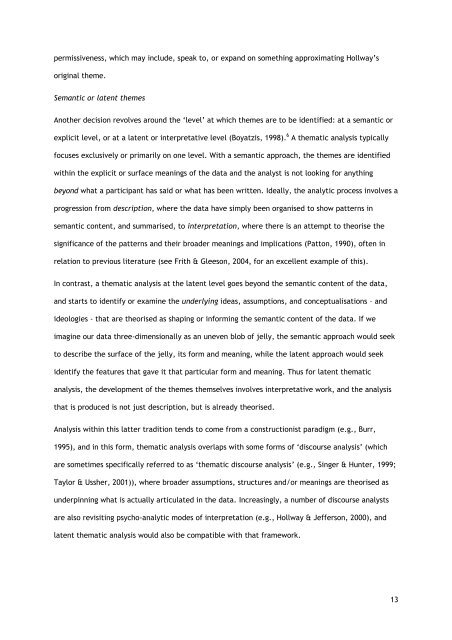Braun, V. and Clarke, V. - UWE Research Repository - University of ...
Braun, V. and Clarke, V. - UWE Research Repository - University of ...
Braun, V. and Clarke, V. - UWE Research Repository - University of ...
Create successful ePaper yourself
Turn your PDF publications into a flip-book with our unique Google optimized e-Paper software.
permissiveness, which may include, speak to, or exp<strong>and</strong> on something approximating Hollway‟s<br />
original theme.<br />
Semantic or latent themes<br />
Another decision revolves around the „level‟ at which themes are to be identified: at a semantic or<br />
explicit level, or at a latent or interpretative level (Boyatzis, 1998). 6 A thematic analysis typically<br />
focuses exclusively or primarily on one level. With a semantic approach, the themes are identified<br />
within the explicit or surface meanings <strong>of</strong> the data <strong>and</strong> the analyst is not looking for anything<br />
beyond what a participant has said or what has been written. Ideally, the analytic process involves a<br />
progression from description, where the data have simply been organised to show patterns in<br />
semantic content, <strong>and</strong> summarised, to interpretation, where there is an attempt to theorise the<br />
significance <strong>of</strong> the patterns <strong>and</strong> their broader meanings <strong>and</strong> implications (Patton, 1990), <strong>of</strong>ten in<br />
relation to previous literature (see Frith & Gleeson, 2004, for an excellent example <strong>of</strong> this).<br />
In contrast, a thematic analysis at the latent level goes beyond the semantic content <strong>of</strong> the data,<br />
<strong>and</strong> starts to identify or examine the underlying ideas, assumptions, <strong>and</strong> conceptualisations – <strong>and</strong><br />
ideologies - that are theorised as shaping or informing the semantic content <strong>of</strong> the data. If we<br />
imagine our data three-dimensionally as an uneven blob <strong>of</strong> jelly, the semantic approach would seek<br />
to describe the surface <strong>of</strong> the jelly, its form <strong>and</strong> meaning, while the latent approach would seek<br />
identify the features that gave it that particular form <strong>and</strong> meaning. Thus for latent thematic<br />
analysis, the development <strong>of</strong> the themes themselves involves interpretative work, <strong>and</strong> the analysis<br />
that is produced is not just description, but is already theorised.<br />
Analysis within this latter tradition tends to come from a constructionist paradigm (e.g., Burr,<br />
1995), <strong>and</strong> in this form, thematic analysis overlaps with some forms <strong>of</strong> „discourse analysis‟ (which<br />
are sometimes specifically referred to as „thematic discourse analysis‟ (e.g., Singer & Hunter, 1999;<br />
Taylor & Ussher, 2001)), where broader assumptions, structures <strong>and</strong>/or meanings are theorised as<br />
underpinning what is actually articulated in the data. Increasingly, a number <strong>of</strong> discourse analysts<br />
are also revisiting psycho-analytic modes <strong>of</strong> interpretation (e.g., Hollway & Jefferson, 2000), <strong>and</strong><br />
latent thematic analysis would also be compatible with that framework.<br />
13

















